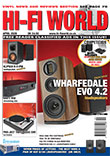USB-to-S/PDIF Convertors - Conclusion |
Page 7 of 7
RAFAEL TODES CONCLUDES Not being a great fan of iTunes as a media player, I tend to use Foobar when using a PC, to extract high resolution audio files from a laptop. I was recently sent a beta version of JPlay, which uses the shell of Foobar or JRiver, and plays within it. I was very impressed with the results I obtained, and used this method to evaluate the different USB/S/PDIF convertors here. A music track takes longer to load, but there seems to be an improved sense of depth, space and timing over the basic Foobar player.
The S/PDIF cables went into my trusted Weiss DAC202, for conversion to analogue. The Weiss has a FireWire output which proved to be a useful reference. My conclusions are that of all the convertors, the Audiophilleo, the most expensive at around £835 was the most sophisticated.
The Halide Bridge, at £269 plus £89 for the optional Aqvox 5V USB power supply proved to be excellent value for money, but it doesn’t go to more than 96k 24bit, which may be a problem for some potential customers, given the recordings that are emerging these days.
The Musical Fidelity was good, and easily upgradable and can stretch to the heady heights of 24bit 192k, which will be attractive to those seeking maximum resolution at a reasonable price.
I was also highly impressed with the combination of JPlay in JRiver that I used for this review and look forward to the time when it works seamlessly with all convertors, as it provides for a noticeable improvement over the basic Foobar player. I listened to these convertors before they were measured and we were all surprised to find measurement correlated so well with what I heard. RT
WINDOWS & MAC HEADACHES Whether you play from Windows or Mac, there are some little headaches that await. Windows needs to have an ASIO audio driver installed, such as the free ASIO4ALL. This worked for us on Windows 7, but not on Vista. It is said to work on XP but we did not try it. Up to 24/192 can be played through this driver. The Halide Bridge and Audiophilleo did not need Windows drivers installed.
Mac OS-X has a built-in ASIO audio interface from 10.6 (Snow Leopard) onward. It worked perfectly with all the convertors in our group, acknowledging the presence of an external clock with the asynchronous models. However, at present core audio on a Mac is limited to 24/96, so 24/192s cannot be played and must be down converted to 24/96 before use.
UPDATE: OS-X 10.7 Lion does work at 24/192 with Cambridge Audio products and they tell us that this is an external software issue and not a Mac core audo limitation.
ASYNCHRONOUS OPERATION Three methods of operation are available to a USB connected device. In the simplest and most obvious, data is sent from the computer to the device in a unidirectional exchange, the device being locked to and passively following the computer. The main issue is that of clock purity; the recovered clock signal is full of jitter and noise from the computer, so even though purifying is possible, this arrangement is now uncommon.
In Adaptive mode the USB device has its own on-board clock and this is locked to the computer clock through a Phase Locked Loop (PLL). It cures many ills, but not all, especially low rate clock wander. The PLL needs a fast lock speed and this conflicts with its response rate. A FIFO buffer is needed too, to buffer data; it adds to cost. With adaptive mode the USB device is still a passive slave, albeit one able to paper over a lot of computer imperfections.
In Asynchronous mode the clock on the USB device takes control; it is not passively locked to the computer. This requires bi-directional communication to the computer and an operating system able to process the requests (Windows and Mac OS-X can do this). A buffer is again needed. The output of an Asynchronous USB convertor is now, in principle at least, locked and of guaranteed quality so the downstream hi-fi is sent a perfect digital. It is up to the device to negotiate with the computer to stay within its buffer limits.
In Adaptive mode the convertor has a low jitter clock, phase-locked to the computer clock. In Asynchronous mode roles are changed: a stable, jitter free convertor clock takes charge, feeding the DAC a perfectly clocked data stream. The computer is controlled by the convertor.
JITTER MEASUREMENT
The S/PDIF signal was fed to our Rohde & Schwarz UPL digital signal analyser, able to accept unbalanced, balanced and optical inputs. A 1kHz, -60dB test tone from a Philips test CD was used and the jitter it induced measured as 'signal related' jitter, a specific form of deterministic jitter. The convertors were fed from a Mac Mini using a 44.1k CD clock at 44.1k (unconverted) and rate converted to 48kHz for a higher jitter signal; we show jitter from the 48k signal to illustrate effectiveness of jitter suppression. DC suppression was used, to give a clear clock drift result.
Thanks to Mark Welsh at Item Audio for supplying four of the convertors, from the many stocked. tel 01782 621225.
Item Audio Duke Street, Fenton Stoke on Trent ST4 3NR |











